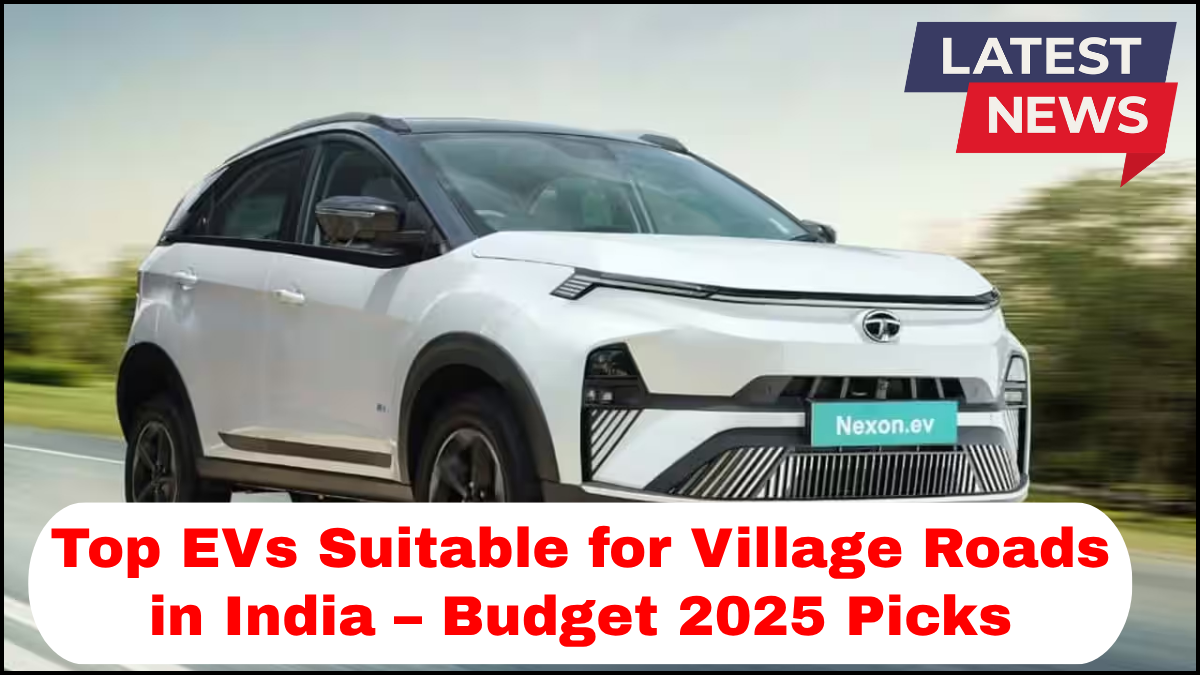As India’s push toward clean mobility gains momentum, electric vehicles (EVs) are no longer limited to urban centers. Villages across the country are starting to adopt EVs, drawn by lower operating costs, minimal maintenance, and government subsidies. However, rural terrains come with unique challenges—uneven roads, limited charging infrastructure, and long distances between service centers. This makes choosing the right EV crucial.

Here’s a list of the best EVs for village roads in India for 2025, carefully selected for their rugged performance, affordability, and suitability for rural conditions.
1. Tata Tiago EV – Reliable and Rugged
Tata’s Tiago EV has made a strong impact as a budget-friendly option for rural and semi-urban buyers. What makes it ideal for village roads?
-
Ground Clearance: At 166mm, it handles rough village paths reasonably well.
-
Battery and Range: Offers a range of up to 250 km on a single charge (Medium Range variant), suitable for daily rural commutes.
-
Affordability: Starts under ₹9 lakh (ex-showroom), making it one of the most accessible EVs.
Tata’s expanding EV service network and build quality make it a solid pick for rural users seeking durability.
2. Mahindra e-Alfa Mini – Practical for Rural Mobility
Designed for last-mile connectivity, the Mahindra e-Alfa Mini is a three-wheeler that suits the ruggedness of village roads.
-
Use Case: Ideal for transporting goods, ferrying school children, or even serving as a shared ride in rural clusters.
-
Sturdy Build: Built with rural use in mind; the suspension and chassis are designed to absorb shocks from potholes and unpaved roads.
-
Running Cost: Operating at roughly ₹0.60/km, it’s among the most economical in the long run.
For those looking at practical mobility solutions in a budget-friendly bracket (₹1.5–2 lakh), this is a reliable pick.
3. PMV EaS-E – Ultra-Compact Yet Capable
One of India’s newest micro-EV entrants, the PMV EaS-E is tailored for urban and semi-rural transport, but it also fits the rural equation well.
-
Size Advantage: Its small size makes it perfect for navigating narrow village roads and congested rural markets.
-
Range: Up to 160 km per charge, more than adequate for intra-village use or short town trips.
-
Price: Around ₹4–5 lakh, hitting the sweet spot for those looking for a budget-friendly option without compromising on tech.
While it’s not suited for heavy-duty use, it works well for individuals or families seeking personal transport.
4. Strom R3 – Smart and Minimalist
The Strom R3 is another micro-EV designed for city roads but with enough capability for light rural use.
-
Design: Three-wheeled, lightweight, and compact. Great for solo riders or small cargo.
-
Efficiency: Uses a 48V battery system and offers around 80–120 km of range.
-
Affordability: Expected price around ₹4.5 lakh.
This model is ideal for rural professionals—teachers, health workers, or small entrepreneurs—looking for an efficient personal commute option.
5. Tata Ace EV – Rural Business Workhorse
Aimed squarely at logistics and small businesses, the Tata Ace EV blends electric innovation with rural ruggedness.
-
Payload: 600 kg, perfect for farm produce, goods, or delivery services.
-
Rural Toughness: Designed to handle bad roads, farm tracks, and sloped areas.
-
Price Bracket: Around ₹8–9 lakh.
This is one of the best EVs for village roads if you’re running a small-scale transport or agri-delivery business.
Why These EVs Stand Out for Village Use
-
Ground Clearance: Key for handling potholes, broken tarmac, and rural dirt tracks.
-
Battery Range: Most villages don’t have charging stations nearby. Vehicles offering 100–250 km range ensure reliability.
-
Affordability: Each of these vehicles falls under ₹10 lakh, making them strong budget-friendly options.
-
After-Sales Support: Tata and Mahindra lead in building EV service networks, now expanding into Tier-2 and rural areas.
Frequently Asked Questions (FAQs)
Q1: Are EVs practical for village roads in India?
Yes. Many EVs today are built with good ground clearance and strong suspensions, making them suitable for rural terrain. Models like the Tata Tiago EV and Mahindra e-Alfa Mini perform well in these conditions.
Q2: How can villagers charge EVs where there are no stations?
EVs can be charged using regular household sockets (slow charging). Many rural homes already use inverters or solar panels, which can be adapted for basic EV charging needs.
Q3: Which is the most budget-friendly EV for rural use?
The Mahindra e-Alfa Mini and PMV EaS-E are among the most budget-friendly options, starting from ₹1.5 lakh and ₹4 lakh respectively.
Q4: Do EVs have lower maintenance costs than petrol vehicles?
Absolutely. EVs have fewer moving parts, no oil changes, and require minimal upkeep, which significantly lowers long-term maintenance costs.
Q5: Can EVs be used for agricultural transport?
Yes. Models like the Tata Ace EV are built for carrying loads and can be used to transport crops, seeds, or equipment over rural distances.
click here to learn more